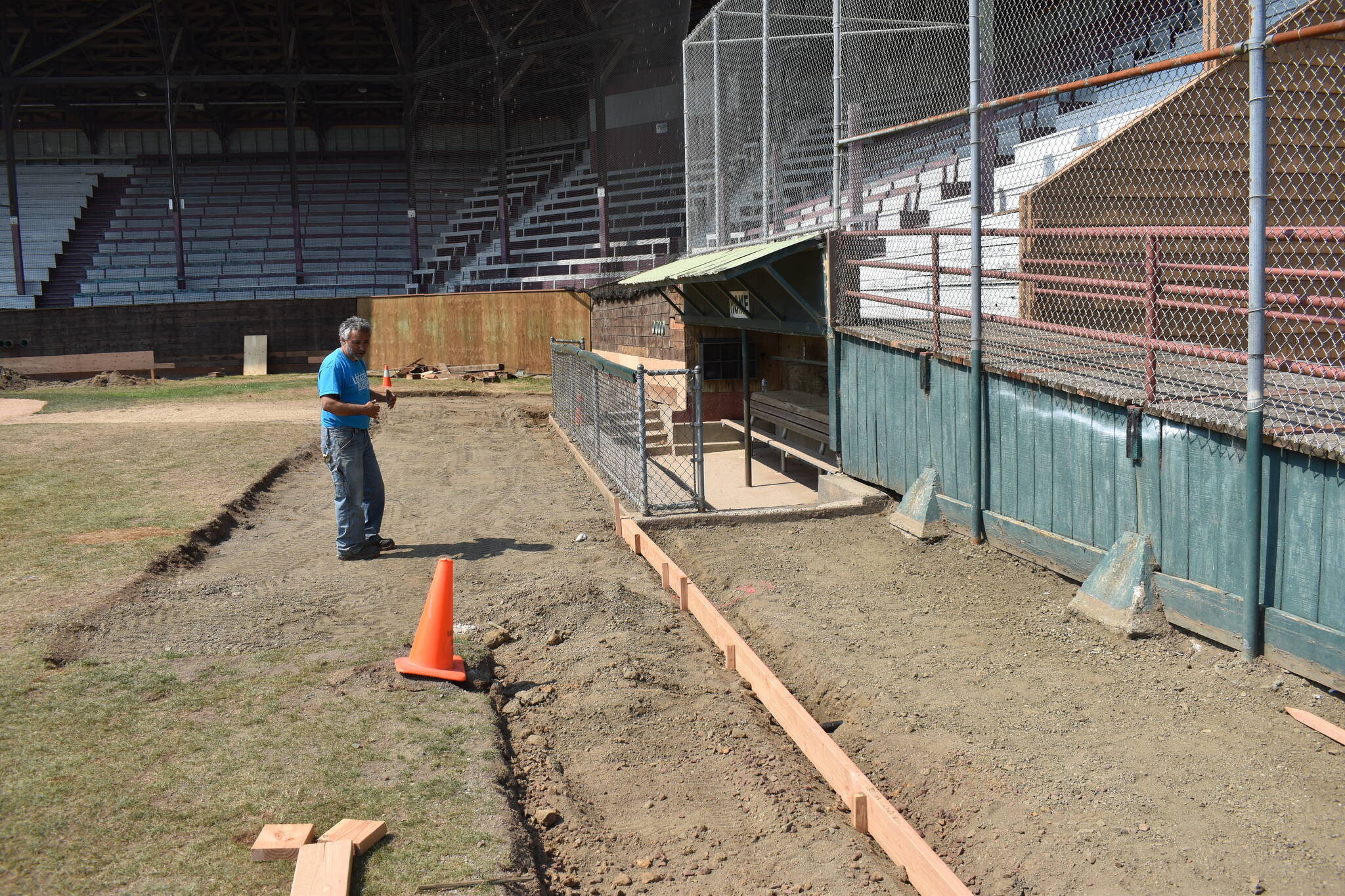Construction is underway on a handful of on-field improvements at historic Olympic Stadium.
Current projects include reroofing two concession stands, building a new awning and fan area in left field, redoing dugouts and replacing rotting boards on the backstop — all items the city of Hoquiam can soon cross off its comprehensive priority list for maintenance on its 85-year-old wooden treasure.
“They’re making good progress,” said Hoquiam City Administrator Brian Shay in an interview on Monday. He said the construction should be finished up in the next few weeks, likely not before Loggers Playday on Sept. 9, but would not in any way interfere with the event.
The city contracted with Coastline Roofing and Construction to complete the work, paid for with a $350,000 competitive grant the city received through the Washington State Recreation and Conservation Office (RCO).
It’s the third phase of construction projects at Olympic Stadium in recent years, said Tracy Wood, community development director for the city of Hoquiam. Last year the city refurbished exterior siding on the stadium with a $900,000 community development grant through the Department of Commerce, and before that installed a fire suppression system.
In 2019 the city hired local firm Harbor Architects to identify and prioritize improvements at Olympic Stadium, according to previous reporting from The Daily World. Since 2018, Shay said, the firm has led all projects at the stadium as design architect and project manager.
All projects on the list are high priority, and their order of completion depends on which grants become available, Shay said. That’s why the current construction phase focuses mostly on field-of-play work.
A new strip of warning track material — a red, dirt-like mixture — will trace the perimeter of the inner field near the dugouts and backstop, said Tom Elledge, maintenance worker with the Hoquiam park’s department. Contractors will expand dugout fences while removing asphalt and green artificial turf in the area. They’ve already replaced rotten wood boards on the backstop.
Left field’s foul territory will likely become a new haven for fans, boasting a fresh wooden awning on the east end of the concession and restroom building. A new fence will be erected to separate fans from the field of play, creating a space with potential for live music and a beer garden, Shay said.
“They’ll be able to sit out here and enjoy the sun during the summer and watch the game,” Elledge said.
The new fence will also keep balls in play that before would’ve rolled out of bounds and been deemed unplayable — although that situation is rarely, if ever, a factor, said Steve Jump, Hoquiam’s varsity baseball coach.
He said the new fence could make fielders slightly more timid when chasing fly balls down the left field line.
On the other side of the outfield, a hazardous concrete stairwell jutting into right center, a locker room entrance for football players, will undergo safety improvements during this phase of construction, Shay said.
“In a baseball game, if somebody blasted one out to centerfield, they could actually fall in making a catch,” Shay said. “We’re making some changes there to prevent that accident or injury from ever happening.”
Olympic Stadium is used for Hoquiam Grizzlies football, baseball and soccer teams, and the host for Hoquiam’s graduation ceremonies. Hoquiam School District leases the stadium from the city for about $30,000 per year, according to Hoquiam Athletic Director Shane Krohn.
For the last several summers the stadium has hosted the wood-bat Cascade Collegiate League, a conglomerate of players from around the Pacific Northwest competing to stay in shape before they return to school in the fall.
In the course of four months in 1938, 400 laborers built Olympic Stadium from a half-million board feet of old-growth timber, logged on the Olympic Peninsula and milled in Hoquiam.
FDR’s New Deal created the Works Progress Administration, which built more than 500 public buildings in Washington from 1935-1940, including Olympic Stadium — the last of that kind in the state, according to the National Register of Historic Places. The stadium was added to the register in 2006.
The stadium, built to hold 10,000 fans, remains the “best-preserved and largest standing wooden grandstand in the United States,” according to the register.
Replacing interior bleacher seating, as well as stadium lighting, are future priority projects, Shay said. He estimated the city will need another three to five million dollars to complete the rest of the work on its priority list, which he hopes will be completed in the next five years.
State and local money has funded all recent maintenance, but Shay said federal funding is a possibility looking forward. U.S. Rep. Derek Kilmer, who represents the Olympic Peninsula, met with city officials at the stadium last fall to discuss funding.
Hoquiam has also received smaller grant amounts from the Grays Harbor Community Foundation. Shay said the city has set up an endowment fund through the foundation that allows people to donate to Olympic Stadium preservation.
“You think of all the people who marched in marching band in that stadium, or they played football there or baseball there, and they’ve gone on and lived their lives and had great careers,” Shay said. “So many people, I think, would want to contribute to saving Olympic Stadium and preserving it.”
Contact Reporter Clayton Franke at 406-552-3917 or clayton.franke@thedailyworld.com.


